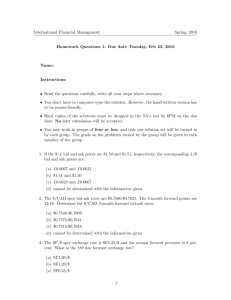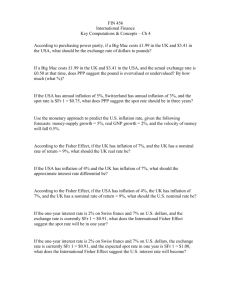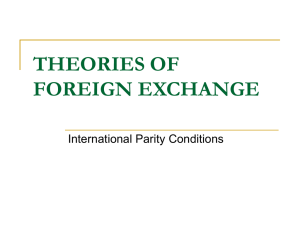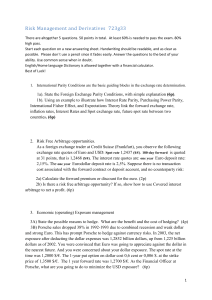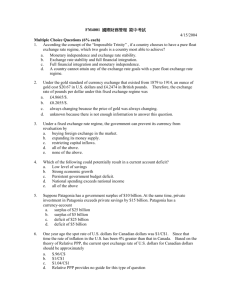CHAPTER 6 INTERNATIONAL PARITY RELATIONSHIPS QUESTIONS AND PROBLEMS
advertisement
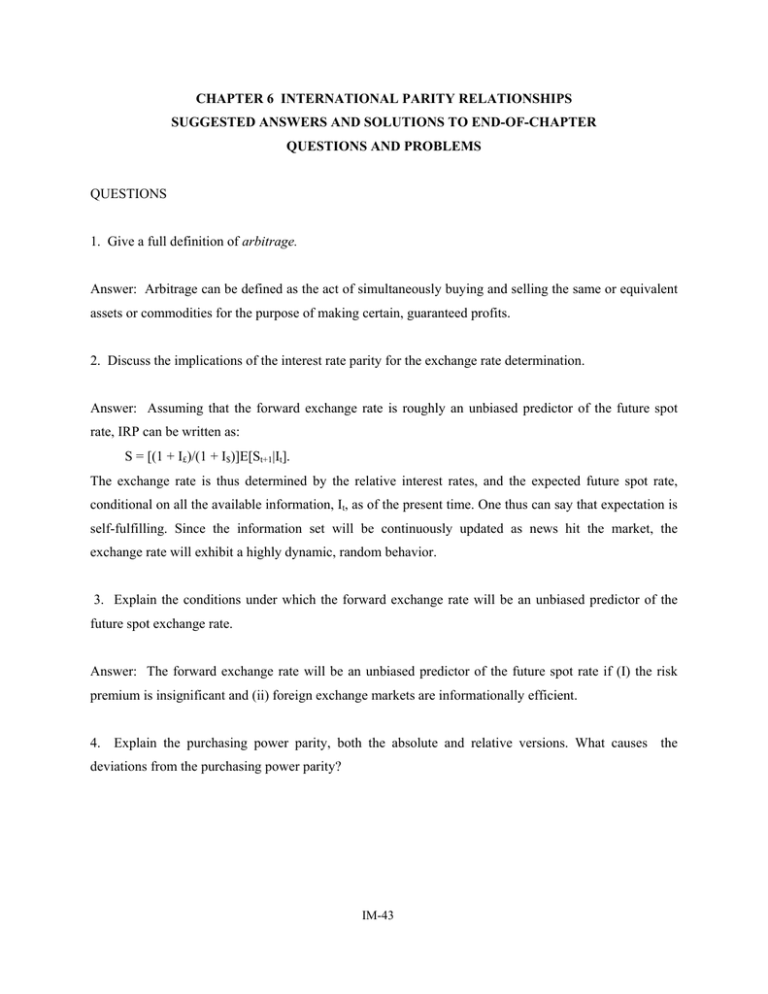
CHAPTER 6 INTERNATIONAL PARITY RELATIONSHIPS SUGGESTED ANSWERS AND SOLUTIONS TO END-OF-CHAPTER QUESTIONS AND PROBLEMS QUESTIONS 1. Give a full definition of arbitrage. Answer: Arbitrage can be defined as the act of simultaneously buying and selling the same or equivalent assets or commodities for the purpose of making certain, guaranteed profits. 2. Discuss the implications of the interest rate parity for the exchange rate determination. Answer: Assuming that the forward exchange rate is roughly an unbiased predictor of the future spot rate, IRP can be written as: S = [(1 + I£)/(1 + I$)]E[St+1It]. The exchange rate is thus determined by the relative interest rates, and the expected future spot rate, conditional on all the available information, It, as of the present time. One thus can say that expectation is self-fulfilling. Since the information set will be continuously updated as news hit the market, the exchange rate will exhibit a highly dynamic, random behavior. 3. Explain the conditions under which the forward exchange rate will be an unbiased predictor of the future spot exchange rate. Answer: The forward exchange rate will be an unbiased predictor of the future spot rate if (I) the risk premium is insignificant and (ii) foreign exchange markets are informationally efficient. 4. Explain the purchasing power parity, both the absolute and relative versions. What causes the deviations from the purchasing power parity? IM-43 Answer: The absolute version of purchasing power parity (PPP): S = P$/P£. The relative version is: e = $ - £. PPP can be violated if there are barriers to international trade or if people in different countries have different consumption taste. PPP is the law of one price applied to a standard consumption basket. 5. Discuss the implications of the deviations from the purchasing power parity for countries’ competitive positions in the world market. Answer: If exchange rate changes satisfy PPP, competitive positions of countries will remain unaffected following exchange rate changes. Otherwise, exchange rate changes will affect relative competitiveness of countries. If a country’s currency appreciates (depreciates) by more than is warranted by PPP, that will hurt (strengthen) the country’s competitive position in the world market. 6. Explain and derive the international Fisher effect. Answer: The international Fisher effect can be obtained by combining the Fisher effect and the relative version of PPP in its expectational form. Specifically, the Fisher effect holds that E($) = I$ - $, E(£) = I£ - £. Assuming that the real interest rate is the same between the two countries, i.e., $ = £, and substituting the above results into the PPP, i.e., E(e) = E($)- E(£), we obtain the international Fisher effect: E(e) = I$ - I£ . 7. Researchers found that it is very difficult to forecast the future exchange rates more accurately than the forward exchange rate or the current spot exchange rate. How would you interpret this finding? Answer: This implies that exchange markets are informationally efficient. Thus, unless one has private information that is not yet reflected in the current market rates, it would be difficult to beat the market. IM-44 8. Explain the random walk model for exchange rate forecasting. Can it be consistent with the technical analysis? Answer: The random walk model predicts that the current exchange rate will be the best predictor of the future exchange rate. An implication of the model is that past history of the exchange rate is of no value in predicting future exchange rate. The model thus is inconsistent with the technical analysis which tries to utilize past history in predicting the future exchange rate. *9. Derive and explain the monetary approach to exchange rate determination. Answer: The monetary approach is associated with the Chicago School of Economics. It is based on two tenets: purchasing power parity and the quantity theory of money. Combing these two theories allows for stating, say, the $/£ spot exchange rate as: S($/£) = (M$/M£)(V$/V£)(y£/y$), where M denotes the money supply, V the velocity of money, and y the national aggregate output. The theory holds that what matters in exchange rate determination are: 1. The relative money supply, 2. The relative velocities of monies, and 3. The relative national outputs. 10. Explain the following three concepts of purchasing power parity (PPP): a. The law of one price. b. Absolute PPP. c. Relative PPP. Answer: a. The law of one price (LOP) refers to the international arbitrage condition for the standard consumption basket. LOP requires that the consumption basket should be selling for the same price in a given currency across countries. b. Absolute PPP holds that the price level in a country is equal to the price level in another country times the exchange rate between the two countries. c. Relative PPP holds that the rate of exchange rate change between a pair of countries is about equal to the difference in inflation rates of the two countries. IM-45 11. Evaluate the usefulness of relative PPP in predicting movements in foreign exchange rates on: a. Short-term basis (for example, three months) b. Long-term basis (for example, six years) Answer. a. PPP is not useful for predicting exchange rates on the short-term basis mainly because international commodity arbitrage is a time-consuming process. b. PPP is more useful for predicting exchange rates on the long-term basis. IM-46 PROBLEMS 1. Suppose that the treasurer of IBM has an extra cash reserve of $100,000,000 to invest for six months. The six-month interest rate is 8 percent per annum in the United States and 7 percent per annum in Germany. Currently, the spot exchange rate is €1.01 per dollar and the six-month forward exchange rate is €0.99 per dollar. The treasurer of IBM does not wish to bear any exchange risk. Where should he/she invest to maximize the return? Solution: The market conditions are summarized as follows: I$ = 4%; i€ = 3.5%; S = €1.01/$; F = €0.99/$. If $100,000,000 is invested in the U.S., the maturity value in six months will be $104,000,000 = $100,000,000 (1 + .04). Alternatively, $100,000,000 can be converted into euros and invested at the German interest rate, with the euro maturity value sold forward. In this case the dollar maturity value will be $105,590,909 = ($100,000,000 x 1.01)(1 + .035)(1/0.99) Clearly, it is better to invest $100,000,000 in Germany with exchange risk hedging. 2. While you were visiting London, you purchased a Jaguar for £35,000, payable in three months. You have enough cash at your bank in New York City, which pays 0.35% interest per month, compounding monthly, to pay for the car. Currently, the spot exchange rate is $1.45/£ and the three-month forward exchange rate is $1.40/£. In London, the money market interest rate is 2.0% for a three-month investment. There are two alternative ways of paying for your Jaguar. (a) Keep the funds at your bank in the U.S. and buy £35,000 forward. (b) Buy a certain pound amount spot today and invest the amount in the U.K. for three months so that the maturity value becomes equal to £35,000. Evaluate each payment method. Which method would you prefer? Why? Solution: The problem situation is summarized as follows: A/P = £35,000 payable in three months iNY = 0.35%/month, compounding monthly iLD = 2.0% for three months S = $1.45/£; F = $1.40/£. IM-47 Option a: When you buy £35,000 forward, you will need $49,000 in three months to fulfill the forward contract. The present value of $49,000 is computed as follows: $49,000/(1.0035)3 = $48,489. Thus, the cost of Jaguar as of today is $48,489. Option b: The present value of £35,000 is £34,314 = £35,000/(1.02). To buy £34,314 today, it will cost $49,755 = 34,314x1.45. Thus the cost of Jaguar as of today is $49,755. You should definitely choose to use “option a”, and save $1,266, which is the difference between $49,755 and $48489. 3. Currently, the spot exchange rate is $1.50/£ and the three-month forward exchange rate is $1.52/£. The three-month interest rate is 8.0% per annum in the U.S. and 5.8% per annum in the U.K. Assume that you can borrow as much as $1,500,000 or £1,000,000. a. Determine whether the interest rate parity is currently holding. b. If the IRP is not holding, how would you carry out covered interest arbitrage? Show all the steps and determine the arbitrage profit. c. Explain how the IRP will be restored as a result of covered arbitrage activities. Solution: Let’s summarize the given data first: S = $1.5/£; F = $1.52/£; I$ = 2.0%; I£ = 1.45% Credit = $1,500,000 or £1,000,000. a. (1+I$) = 1.02 (1+I£)(F/S) = (1.0145)(1.52/1.50) = 1.0280 Thus, IRP is not holding exactly. b. (1) Borrow $1,500,000; repayment will be $1,530,000. (2) Buy £1,000,000 spot using $1,500,000. (3) Invest £1,000,000 at the pound interest rate of 1.45%; maturity value will be £1,014,500. (4) Sell £1,014,500 forward for $1,542,040 Arbitrage profit will be $12,040 IM-48 c. Following the arbitrage transactions described above, The dollar interest rate will rise; The pound interest rate will fall; The spot exchange rate will rise; The forward exchange rate will fall. These adjustments will continue until IRP holds. 4. Suppose that the current spot exchange rate is €0.80/$ and the three-month forward exchange rate is €0.7813/$. The three-month interest rate is 5.6 percent per annum in the United States and 5.40 percent per annum in France. Assume that you can borrow up to $1,000,000 or €800,000. a. Show how to realize a certain profit via covered interest arbitrage, assuming that you want to realize profit in terms of U.S. dollars. Also determine the size of your arbitrage profit. b. Assume that you want to realize profit in terms of euros. Show the covered arbitrage process and determine the arbitrage profit in euros. Solution: a. (1+ i$) = 1.014 < (S/F) (1+ i € ) = 1.0378. Thus, one has to borrow dollars and invest in euros to make arbitrage profit. 1. Borrow $1,000,000 and repay $1,014,000 in three months. 2. Sell $1,000,000 spot for €800,000. 3. Invest €800,000 at the euro interest rate of 1.35 % for three months and receive €810,800 at maturity. 4. Sell €810,800 forward for $1,037,758. Arbitrage profit = $1,037,758 - $1,014,000 = $23,758. b. Follow the first three steps above. But the last step, involving exchange risk hedging, will be different. 5. Buy $1,014,000 forward for €1,034,280. Arbitrage profit = €1,074,310 - €1,034,280 = €40,030 IM-49 5. In the issue of October 23, 1999, the Economist reports that the interest rate per annum is 5.93% in the United States and 70.0% in Turkey. Why do you think the interest rate is so high in Turkey? Based on the reported interest rates, how would you predict the change of the exchange rate between the U.S. dollar and the Turkish lira? Solution: A high Turkish interest rate must reflect a high expected inflation in Turkey. According to international Fisher effect (IFE), we have E(e) = i$ - iLira = 5.93% - 70.0% = -64.07% The Turkish lira thus is expected to depreciate against the U.S. dollar by about 64%. 6. As of November 1, 1999, the exchange rate between the Brazilian real and U.S. dollar is R$1.95/$. The consensus forecast for the U.S. and Brazil inflation rates for the next 1-year period is 2.6% and 20.0%, respectively. How would you forecast the exchange rate to be at around November 1, 2000? Solution: Since the inflation rate is quite high in Brazil, we may use the purchasing power parity to forecast the exchange rate. E(e) = E($) - E(R$) = 2.6% - 20.0% = -17.4% E(ST) = So(1 + E(e)) = (R$1.95/$) (1 + 0.174) = R$2.29/$ IM-50 7. (CFA question) Omni Advisors, an international pension fund manager, uses the concepts of purchasing power parity (PPP) and the International Fisher Effect (IFE) to forecast spot exchange rates. Omni gathers the financial information as follows: Base price level 100 Current U.S. price level 105 Current South African price level 111 Base rand spot exchange rate $0.175 Current rand spot exchange rate $0.158 Expected annual U.S. inflation 7% Expected annual South African inflation 5% Expected U.S. one-year interest rate 10% Expected South African one-year interest rate 8% Calculate the following exchange rates (ZAR and USD refer to the South African and U.S. dollar, respectively). a. The current ZAR spot rate in USD that would have been forecast by PPP. b. Using the IFE, the expected ZAR spot rate in USD one year from now. c. Using PPP, the expected ZAR spot rate in USD four years from now. Solution: a. ZAR spot rate under PPP = [1.05/1.11](0.175) = $0.1655/rand. b. Expected ZAR spot rate = [1.10/1.08] (0.158) = $0.1609/rand. c. Expected ZAR under PPP = [(1.07)4/(1.05)4] (0.158) = $0.1704/rand. 8. Suppose that the current spot exchange rate is €1.50/₤ and the one-year forward exchange rate is €1.60/₤. The one-year interest rate is 5.4% in euros and 5.2% in pounds. You can borrow at most €1,000,000 or the equivalent pound amount, i.e., ₤666,667, at the current spot exchange rate. a. Show how you can realize a guaranteed profit from covered interest arbitrage. Assume that you are a euro-based investor. Also determine the size of the arbitrage profit. b. Discuss how the interest rate parity may be restored as a result of the above transactions. c. Suppose you are a pound-based investor. Show the covered arbitrage process and determine the pound profit amount. IM-51 Solution: a. First, note that (1+i €) = 1.054 is less than (F/S)(1+i €) = (1.60/1.50)(1.052) = 1.1221. You should thus borrow in euros and lend in pounds. 1) Borrow €1,000,000 and promise to repay €1,054,000 in one year. 2) Buy ₤666,667 spot for €1,000,000. 3) Invest ₤666,667 at the pound interest rate of 5.2%; the maturity value will be ₤701,334. 4) To hedge exchange risk, sell the maturity value ₤701,334 forward in exchange for €1,122,134. The arbitrage profit will be the difference between €1,122,134 and €1,054,000, i.e., €68,134. b. As a result of the above arbitrage transactions, the euro interest rate will rise, the pound interest rate will fall. In addition, the spot exchange rate (euros per pound) will rise and the forward rate will fall. These adjustments will continue until the interest rate parity is restored. c. The pound-based investor will carry out the same transactions 1), 2), and 3) in a. But to hedge, he/she will buy €1,054,000 forward in exchange for ₤658,750. The arbitrage profit will then be ₤42,584 = ₤701,334 - ₤658,750. 9. Due to the integrated nature of their capital markets, investors in both the U.S. and U.K. require the same real interest rate, 2.5%, on their lending. There is a consensus in capital markets that the annual inflation rate is likely to be 3.5% in the U.S. and 1.5% in the U.K. for the next three years. The spot exchange rate is currently $1.50/£. a. Compute the nominal interest rate per annum in both the U.S. and U.K., assuming that the Fisher effect holds. b. What is your expected future spot dollar-pound exchange rate in three years from now? c. Can you infer the forward dollar-pound exchange rate for one-year maturity? Solution. a. Nominal rate in US = (1+ρ) (1+E(π$)) – 1 = (1.025)(1.035) – 1 = 0.0609 or 6.09%. Nominal rate in UK= (1+ρ) (1+E(π₤)) – 1 = (1.025)(1.015) – 1 = 0.0404 or 4.04%. b. E(ST) = [(1.0609)3/(1.0404)3] (1.50) = $1.5904/₤. c. F = [1.0609/1.0404](1.50) = $1.5296/₤. IM-52 10. After studying Iris Hamson’s credit analysis, George Davies is considering whether he can increase the holding period return on Yucatan Resort’s excess cash holdings (which are held in pesos) by investing those cash holdings in the Mexican bond market. Although Davies would be investing in a pesodenominated bond, the investment goal is to achieve the highest holding period return, measured in U.S. dollars, on the investment. Davies finds the higher yield on the Mexican one-year bond, which is considered to be free of credit risk, to be attractive but he is concerned that depreciation of the peso will reduce the holding period return, measured in U.S. dollars. Hamson has prepared selected economic and financial data, given in Exhibit 3-1, to help Davies make the decision. Selected Economic and Financial Data for U.S. and Mexico Expected U.S. Inflation Rate 2.0% per year Expected Mexican Inflation Rate 6.0% per year U.S. One-year Treasury Bond Yield 2.5% Mexican One-year Bond Yield 6.5% Spot One-year Forward Nominal Exchange Rates 9.5000 Pesos = U.S. $ 1.00 9.8707 Pesos = U.S. $ 1.00 Hamson recommends buying the Mexican one-year bond and hedging the foreign currency exposure using the one-year forward exchange rate. She concludes: “This transaction will result in a U.S. dollar holding period return that is equal to the holding period return of the U.S. one-year bond.” a. Calculate the U.S. dollar holding period return that would result from the transaction recommended by Hamson. Show your calculations. State whether Hamson’s conclusion about the U.S. dollar holding period return resulting from the transaction is correct or incorrect. After conducting his own analysis of the U.S. and Mexican economies, Davies expects that both the U.S. inflation rate and the real exchange rate will remain constant over the coming year. Because of favorable political developments in Mexico, however, he expects that the Mexican inflation rate (in annual terms) will fall from 6.0 percent to 3.0 percent before the end of the year. As a result, Davies decides to invest Yucatan Resorts’ cash holdings in the Mexican one-year bond but not to hedge the currency exposure. b. Calculate the expected exchange rate (pesos per dollar) one year from now. Show your calculations. Note: Your calculations should assume that Davies is correct in his expectations about the real exchange rate and the Mexican and U.S. inflation rates. IM-53 c. Calculate the expected U.S. dollar holding period return on the Mexican one-year bond. Show your calculations. Note: Your calculations should assume that Davies is correct in his expectations about the real exchange rate and the Mexican and U.S. inflation rates. Solution: a. The U.S. dollar holding period return that would result from the transaction recommended by Hamson is 2.5%. The investor can buy “x” amount of pesos at the (indirect) spot exchange rate, invest these “x” pesos in the Mexican bond market and have “x × (1 + YMEX)” pesos in one year, and convert these pesos back into dollars using the (indirect) forward exchange rate. Interest rate parity asserts that the two holding period returns must be equal, which can be represented by the formula: (1 + YUS) = Spot × (1 + YMEX) × (1 / Forward) where “Spot” and “Forward” are in indirect terms. The left side of the equation represents the holding period return for a U.S. dollar-denominated bond. If interest rate parity holds, the “YUS” term also corresponds to the U.S. dollar holding period return for the currency-hedged Mexican one-year bond. The right side of the equation is the holding period return, in dollar terms, for a currency-hedged peso-denominated bond. Solving for YUS: (1 + YUS) = 9.5000 × (1 + 0.065) × (1 / 9.8707) (1 + YUS) = 9.5000 × 1.065 × 0.1013 (1 + YUS) = 1.0249 YUS = 1.0249 – 1.0000 = 0.0249 = 2.5% Thus YUS = 2.5%, which is the same yield as on the one-year U.S. bond. Hamson’s conclusion about the U.S. dollar holding period return is correct. b. The expected exchange rate one year from now is 9.5931. The rate can be calculated by using the formula: (1 + %Δ RUS) = (1 + %Δ SUS) × [(1 + %Δ PUS) / (1 + %Δ PMEX)] = (S1 / S0) × [(1 + %Δ PUS) / (1 + %Δ PMEX)] where RUS is the real U.S. dollar exchange rate, Si is the nominal spot exchange rate in period i, and %Δ P is the inflation rate. Note that the currency quotes are in indirect form. Solving for S1 (the expected exchange rate one year from now): IM-54 (1 + 0.0000) = (S1 / 9.5000) × [(1 + 0.02) / (1 + 0.03)] 1.0000 = (S1 / 9.5000) × 0.9903 1.0098 = S1 / 9.5000 S1 = 9.5931 c. The expected U.S. dollar holding period return on the Mexican one-year bond is 5.47%. The return can be calculated as shown below, using the formula in Part A and the current spot exchange rate and expected one-year spot exchange rate calculated in Part B. Holding period return = [(1 + YMEX) × (1 + %Δ peso’s value)] – 1 = [(1 + YMEX) × (S0 / S1)] – 1 = [(1 + 0.065) × (9.5000 / 9.5931)] – 1 = (1.065 × 0.9903) – 1 = 5.47% 11. Jason Smith is a foreign exchange trader with Citibank. He notices the following quotes. Spot exchange rate SFr1.6627/$ Six-month forward exchange rate SFr1.6558/$ Six-month $ interest rate 3.5% per year Six-month SFr interest rate 3.0% per year a. Ignoring transaction costs, is the interest rate parity holding? b. Is there an arbitrage possibility? If yes, what steps would be needed to make an arbitrage profit? Assuming that Jason Smith is authorized to work with $1,000,000 for this purpose, how much would the arbitrage profit be in dollars? Solution: a. For six months, rSFr = 1.50% and r$ = 1.75%. Because the exchange rate is in SFr/$ terms, the appropriate expression for the interest rate parity relation is F 1 rSFr F , or (1 r$ ) (1 rSFr ) S 1 r$ S The left side of this expression is IM-55 F 1.6558 (1 r$ ) (1 0.0175) 1.0133 S 1.6627 The right side of the expression is: 1 + rSFr = 1.0150. Because the left and right sides are not equal, IRP is not holding. b. Because IRP is not holding, there is an arbitrage possibility: Because 1.0133 < 1.0150, we can say that the SFr interest rate quote is more than what it should be as per the quotes for the other three variables. Equivalently, we can also say that the $ interest rate quote is less than what it should be as per the quotes for the other three variables. Therefore, the arbitrage strategy should be based on borrowing in the $ market and lending in the SFr market. The steps would be as follows: Borrow $1,000,000 for six months at 3.5% per year. Need to pay back $1,000,000 × (1 + 0.0175) = $1,017,500 six months later. Convert $1,000,000 to SFr at the spot rate to get SFr 1,662,700. Lend SFr 1,662,700 for six months at 3% per year. Will get back SFr 1,662,700 × (1 + 0.0150) = SFr 1,687,641 six months later. Sell SFr 1,687,641 six months forward. The transaction will be contracted as of the current date but delivery and settlement will only take place six months later. So, six months later, exchange SFr 1,687,641 for SFr 1,687,641/SFr 1.6558/$ = $1,019,230. The arbitrage profit six months later is 1,019,230 – 1,017,500 = $1,730. Mini Case: Turkish Lira and the Purchasing Power Parity Veritas Emerging Market Fund specializes in investing in emerging stock markets of the world. Mr. Henry Mobaus, an experienced hand in international investment and your boss, is currently interested in Turkish stock markets. He thinks that Turkey will eventually be invited to negotiate its membership in the European Union. If this happens, it will boost the stock prices in Turkey. But, at the same time, he is quite concerned with the volatile exchange rates of the Turkish currency. He would like to understand what drives the Turkish exchange rates. Since the inflation rate is much higher in Turkey than in the U.S., he thinks that the purchasing power parity may be holding at least to some extent. As a research assistant for him, you were assigned to check this out. In other words, you have to study and prepare a report on the following question: Does the purchasing power parity hold for the Turkish lira-U.S. dollar exchange rate? Among other things, Mr. Mobaus would like you to do the following: a. Plot the past exchange rate changes against the differential inflation rates between Turkey and the U.S. for the last four years. IM-56 b. Regress the rate of exchange rate changes on the inflation rate differential to estimate the intercept and the slope coefficient, and interpret the regression results. Data source: You may download the consumer price index data for the U.S. and Turkey from the following website: http://www.oecd.org/EN/statistics/0,,EN-statistics-0-nodirectorate-no-no-no-0,00.html , “hot file” (Excel format) . You may download the exchange rate data from the website: http://pacific.commerce.ubc.ca/xr/data.html. Solution: a. In the current solution, we use the monthly data from January 1999 – December 2002. Turkey vs. U.S. Rate of Change of TL/$ (e) 0.15 0.10 β̂ 1.47 0.05 0.00 α̂ 0.011 -0.05 -0.05 0 0.05 0.1 0.15 Inf_Turkey - Inf_US b. We regress exchange rate changes (e) on the inflation rate differential and estimate the intercept (α ) and slope coefficient (β): e t α̂ β̂( Inf_Turkey - Inf_US) ε t α̂ 0.011 (t - 0.649) β̂ 1.472 (t 3.095) IM-57 The estimated intercept is insignificantly different from zero, whereas the slope coefficient is positive and significantly different from zero. In fact, the slope coefficient is insignificantly different from unity. [Note that t-statistics for β = 1 is 0.992 = (1.472 – 1)/0.476 where s.e. is 0.476] In other words, we cannot reject the hypothesis that the intercept is zero and the slope coefficient is one. The results are thus supportive of purchasing power parity. IM-58

